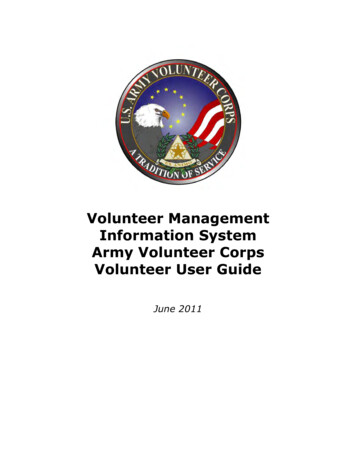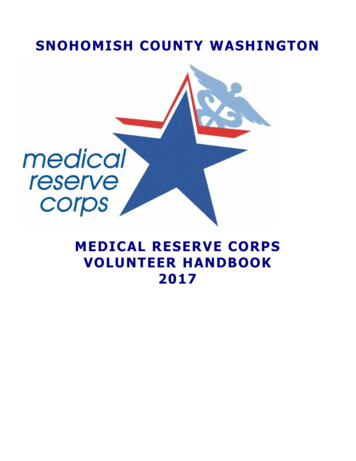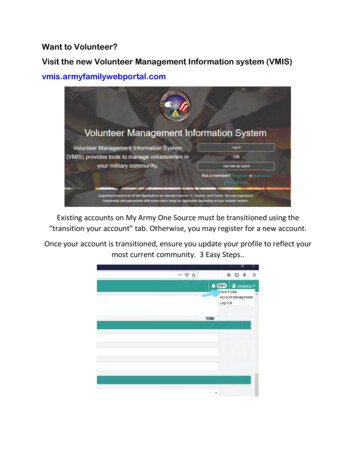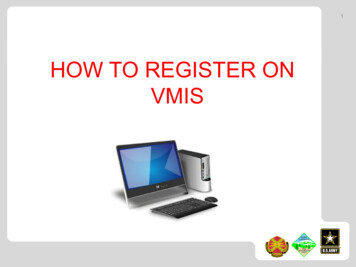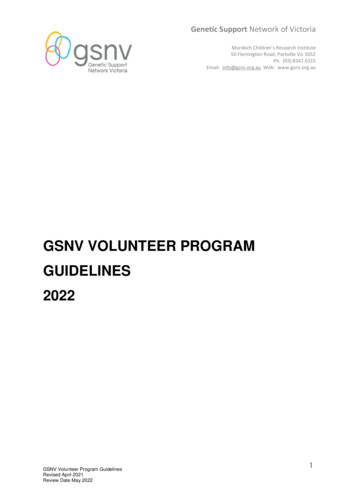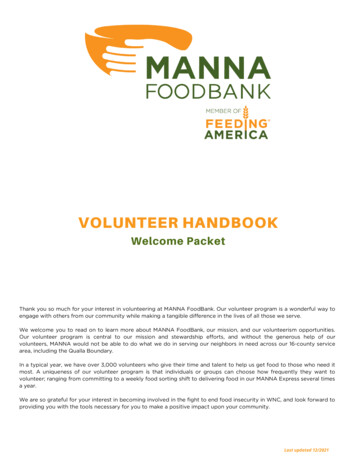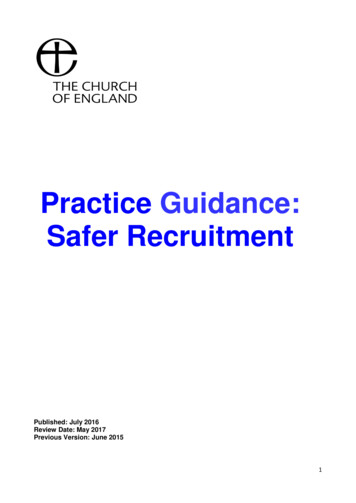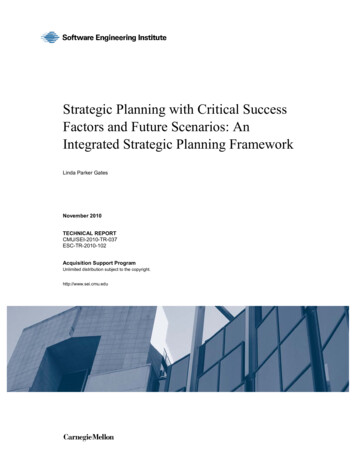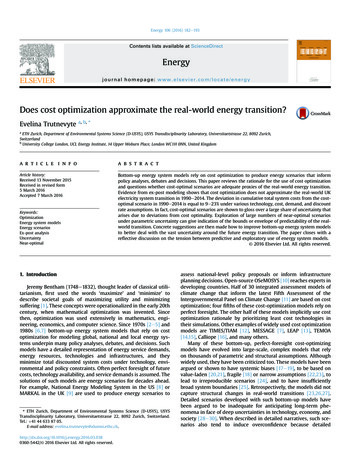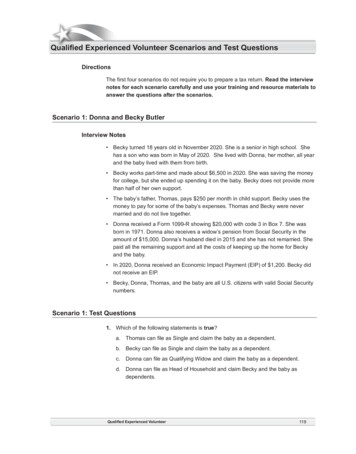
Transcription
Qualified Experienced Volunteer Scenarios and Test QuestionsDirectionsThe first four scenarios do not require you to prepare a tax return. Read the interviewnotes for each scenario carefully and use your training and resource materials toanswer the questions after the scenarios.Scenario 1: Donna and Becky ButlerInterview Notes Becky turned 18 years old in November 2020. She is a senior in high school. Shehas a son who was born in May of 2020. She lived with Donna, her mother, all yearand the baby lived with them from birth. Becky works part-time and made about 6,500 in 2020. She was saving the moneyfor college, but she ended up spending it on the baby. Becky does not provide morethan half of her own support. The baby’s father, Thomas, pays 250 per month in child support. Becky uses themoney to pay for some of the baby’s expenses. Thomas and Becky were nevermarried and do not live together. Donna received a Form 1099-R showing 20,000 with code 3 in Box 7. She wasborn in 1971. Donna also receives a widow’s pension from Social Security in theamount of 15,000. Donna’s husband died in 2015 and she has not remarried. Shepaid all the remaining support and all the costs of keeping up the home for Beckyand the baby. In 2020, Donna received an Economic Impact Payment (EIP) of 1,200. Becky didnot receive an EIP. Becky, Donna, Thomas, and the baby are all U.S. citizens with valid Social Securitynumbers.Scenario 1: Test Questions1. Which of the following statements is true?a. Thomas can file as Single and claim the baby as a dependent.b. Becky can file as Single and claim the baby as a dependent.c.Donna can file as Qualifying Widow and claim the baby as a dependent.d. Donna can file as Head of Household and claim Becky and the baby asdependents.Qualified Experienced Volunteer119
2. The person eligible to claim the baby as a dependent can also claim which of thefollowing credits:a. Earned income credit and additional child tax creditb. Earned Income credit, additional child tax credit, and credit for the elderly anddisabledc.Additional child tax credit.d. The baby is not a qualifying child for any of the credits3. The person eligible to claim the baby as a dependent can also claim a 500 recovery rebate credit on their 2020 tax return.Note: Congress may have enacted additional legislation that will affect taxpayersafter this publication went to print. Please answer questions based on the information provided in Publication 4491, VITA/TCE Training Guide and Publication 4012,VITA/TCE Resource Guide.a. Trueb. False120Qualified Experienced Volunteer
Scenario 2: Clare Ellsworth and Her ParentsInterview Notes Clare is 21 years old and a full-time college junior majoring in nursing. She residesin the campus dorm when school is in session, but lives with her parents duringthe summer. Clare spent 1,000 on books. Clare works at the Campus Pharmacy on weekends, but it doesn’t cover all of herexpenses. Clare received a Form W-2 from the Campus Pharmacy as shown on thefollowing page. Clare’s parents are providing the majority of her support. Clare has not been convicted of any felony. She also received Form 1098-T as shown on the following page. The Box 5 amountwas an unrestricted scholarship. Clare and her parents came to the site to have their returns prepared. They want tomaximize the tax benefits for the family.Qualified Experienced Volunteer121
122Qualified Experienced Volunteer
Scenario 2: Test Questions4. Clare’s parents would like to claim the American opportunity credit on their taxreturn. What treatment would provide Clare and her parents the most favorableoutcome?a. Neither Clare nor her parents can claim the credit because the scholarshipincome was more than education expenses.b. Clare includes 5,000 as taxable scholarship income and her parents claim 3,000 in qualified education expenses.c.Clare includes 3,000 in taxable scholarship income and her parents claim 3,000 in qualified education expenses.d. Clare does not need to report any scholarship income because it was foreducational purposes and her parents claim 4,000 in qualified educationexpenses.5. Which of the following statements is true?a. Clare is not required to file a tax return because her gross income is below thefiling threshold.b. Clare is required to file because her total income is over 4,300 and herparents cannot claim her.c.Clare is required to file because her parents can claim her as a dependent andher income is over 4,300.d. Clare’s unearned income is over 2,200; therefore, the Kiddie Tax applies andher return is out of scope.Qualified Experienced Volunteer123
Scenario 3: Genevieve ChabotInterview Notes Under a joint and survivor annuity, Genevieve is receiving widow’s benefits from herdeceased husband’s pension. Genevieve’s date of birth is 5/31/1965. Joe, Genevieve’s husband, retired at age 60 on January 1, 2010 and began receiving his pension benefits immediately. He died in 2015. Genevieve received a Form 1099-R, as shown below. Genevieve didn’t bring last year’s tax return and claims the full amount of the retirement distribution was taxed in previous years. Genevieve is a U.S. citizen with a valid Social Security number.124Qualified Experienced Volunteer
Scenario 3: Test Questions6. What age is used to compute the taxable amount of the pension using theSimplified Method?7. Using the Simplified Method, you determine the taxable amount of the distributionis 13,054. How much should be entered as the amount previously recovered inthe simplified method worksheet?a. 0b. 146c. 1,460d. 5,000Qualified Experienced Volunteer125
Scenario 4: Barbara DrakeDirectionsThis scenario does not require you to prepare a tax return. Refer to the interview notesand accompanying Forms 1099-NEC and 1099-K for the information needed to answerthe questions that follow.Interview Notes Barbara is a self-employed rideshare driver for Widget Ride Share. Barbara provided a statement from the ride share company that indicated the amountof mileage driven and fees paid for the year. These fees are considered ordinary andnecessary for the ride share business:– 5,775 miles driven while transporting customers– Ride share fee: 1,200– Safe driver fee: 50– Airport fee: 115– GPS device fee: 120 Her recordkeeping application shows she also drove 3,225 miles between rides and2,134 miles driven between her home and her first and last customer of the day.Barbara has a separate car for personal use. She bought and started using her secondcar for business on September 1, 2020. She kept receipts showing she spent 129 ontolls and 960 on gasoline. Barbara also provided the Form 1099-NEC and Form 1099-K that she received fromWidget. See the next page.126Qualified Experienced Volunteer
Qualified Experienced Volunteer127
Scenario 4: Test Questions8. What is the total of Barbara’s self-employment expenses on Schedule C?a. 4,935b. 6,789c. 7,749d. 8,0169. Which of the following statements regarding self-employment tax is false?a. Self-employment tax is Social Security and Medicare taxes collected primarilyfrom individuals who work for themselves, similar to the Social Security andMedicare taxes withheld from the pay of most wage earners.b. The Social Security Administration uses the information from Schedule SE tofigure a person’s benefits under the Social Security program.c.Taxpayers who are already getting Social Security or Medicare benefits are notrequired to pay self-employment taxes.d. Taxpayers who do not report all of their self-employment income could causetheir Social Security benefits to be lower when they retire.128Qualified Experienced Volunteer
Scenario 5: Kenneth and Martha KemperDirectionsUsing the tax software, complete the tax return, including Form 1040 and all appropriate forms, schedules, or worksheets. Answer the questions following the scenario. Toensure the accuracy of the taxpayer’s return the volunteer should review and completethe applicable sections of the Form 13614-C.Note: When entering Social Security numbers (SSNs) or Employer IdentificationNumbers (EINs), replace the Xs as directed, or with any four digits of your choice.Interview Notes Kenneth and Martha are married and would like to file a joint return. Kenneth applied for Social Security Disability benefits in July 2018, and he beganreceiving benefits in December 2020. The payment included a lump sum distribution for the time Kenneth’s application was pending in 2018 and 2019. Kenneth andMartha filed a joint return each year. In 2018, their modified adjusted gross incomewas 33,600, and in 2019 their modified adjusted gross income was 35,229.Martha has never received Social Security benefits. Kenneth and Martha have never itemized their deductions. Kenneth and Martha received a state income tax refund of 230. Martha was enrolled in her employer’s high deductible health plan (HDHP) with selfonly coverage for all of 2020. Martha’s employer did not offer family coverage. Martha contributed 520 to her Health Savings Account in 2020. Her contributionswere made pre-tax through her employer’s cafeteria plan. Martha’s only medical expenses for the year were two doctor visits totaling 80. Kenneth purchased health care coverage through the Marketplace, which he had allyear. The Kempers received an Economic Impact Payment (EIP) of 2,400 in 2020. If the Kempers are due a refund, they want it direct deposited to their checkingaccount. Bank Routing is 111000022; Checking Account number is 1234567890. Ifthey have a balance due, they will mail in the payment.Qualified Experienced Volunteer129
130Qualified Experienced Volunteer
Qualified Experienced Volunteer131
132Qualified Experienced Volunteer
Qualified Experienced Volunteer Retest Questions133
134Qualified Experienced Volunteer
ABC INVESTMENTS2020 TAX REPORTING STATEMENT456 Pima PlazaYour City, YS ZIPKenneth Kemper8705 Skidmore WayYour City, YS ZIPAccount No. 111-222Recipient ID No. 457-00-XXXXPayer’s Fed ID Number: 25-8XXXXXXFORM 1099-B* 2020 Proceeds from Broker and Barter Exchange TransactionsCopy B for Recipient OMB NO. 1545-0715Short-term transactions for which basis is reported to the IRSReport on Form 8949 with Box A checked(This Label is a Substitute for Boxes 1c & 6)8 Description, 1d Stock or Other Symbol, CUSIPActivityType1a QuantitySold1b DateAcquired1c Date Soldor DisposedUSA EXAMPLE / 556435200 / ABCPX1/31/2020(IRS Form 1099-B box numbers are shown below in bold type)1d Proceeds1e Cost orOther BasisUnadjustedGain / Loss (-)1f AccruedMarketDiscount1g Wash SaleLossDisallowed174.984 FederalIncome 8Sale85.8810002/11/2020 2020 5/14/2020 12/31/20207 Loss Not AllowedBased on Amountin Box 1d0.00936.56900.1236.44Subtotal TOTALS5,104.094,502.22601.870.00174.980.00This is important tax information and is being furnished to the Internal Revenue Service. If you are required to file a return, a negligence penaltyor other sanction may be imposed on you if this income is taxable and the IRS determines that it has not been reported.Page 1 of 1Qualified Experienced Volunteer135
136Qualified Experienced Volunteer
Qualified Experienced Volunteer137
Scenario 5: Test Questions10. How much of Kenneth and Martha’s state income tax refund is taxable?a. 0b. 23c. 115d. 23011. What are the advantages of completing the lump-sum Social Security worksheet forKenneth?a. It reduces the taxable portion of Social Security benefits.b. It reduces the amount of premium tax credit that must be repaid.c. There is no benefit to completing the worksheet.d. Both a and b12. What is the taxable portion of Kenneth’s Social Security? .13. What is the total amount of adjustments on Form 8949, Part I, Line 2g? (Round tothe nearest dollar.) .14. How does the Distribution Code 2 on Kenneth’s Form 1099-R affect their taxreturn?a. Kenneth must complete Form 5329 to claim an exception to the 10% penaltyon early distributions because he is not age 59 1/2.b. Kenneth must pay a 10% penalty on early distributions because he is not yet59 1/2.c.The payer has indicated that an exception to the 10% penalty on earlydistributions applies, and Kenneth does not need to complete Form 5329 toclaim it.d. The payer has indicated that an exception to the 10% penalty on earlydistributions applies, but Kenneth must still complete Form 5329 to claim it.15. What is the amount of deductible contributions made to Martha’s HSA in 2020?a. 0b. 80c. 520d. 600138Qualified Experienced Volunteer
Scenario 6: John Cameron and Amy CamdenDirectionsThe completion of a tax return is not required for this scenario. A completed returnis provided. Perform a quality review of the return, comparing the intake sheet andtaxpayer source documents. Answer the questions following the scenario.Interview Notes John and Amy are married. John is age 61, Amy is age 49. Neither are blind. John draws Social SecurityDisability income (SSDI) and tutors part time for extra cash. When asked aboutexpenses, John stated that he spent 200 on supplies for tutoring his students. Amyteaches preschool. Amy won 5,000 at the local casino. She has 4,900 in gambling losses. They have two sons, Brad and Craig, who live with them. Brad is 14 years old. John and Amy pay more than half the support for Brad. Craig is 21 years old, is not a full-time student, receives SSDI of 10,000, and usesit to provide more than half of his own support. Craig is totally and permanentlydisabled. Amy has family coverage through a High Deductible Health Plan at work. She useda distribution from her HSA to pay for two pairs of prescription eyeglasses for Brad. John pays 6,000 alimony to his ex-wife Kim. Their divorce was finalized October10, 2004. Kim’s Social Security number is 568-00-XXXX. John and Amy paid 500 total in quarterly estimated tax payments. John and Amy received an Economic Impact Payment (EIP) of 2,900 in 2020. John was a victim of identity theft and received an Identity Protection PIN from theIRS. The PIN is 654708.Qualified Experienced Volunteer139
140Qualified Experienced Volunteer
Qualified Experienced Volunteer141
142Qualified Experienced Volunteer
Qualified Experienced Volunteer143
144Qualified Experienced Volunteer
Qualified Experienced Volunteer145
146Qualified Experienced Volunteer
Qualified Experienced Volunteer147
148Qualified Experienced Volunteer
Qualified Experienced Volunteer149
150Qualified Experienced Volunteer
Qualified Experienced Volunteer151
152Qualified Experienced Volunteer
Qualified Experienced Volunteer153
Scenario 6: Test Questions16. Consider the following factors: Name, SSN, Birthdate, Age/Blindness section,Dependents section. Whose information is correct? (Select all that apply):a. Johnb. Amyc. Bradd. Craige. None of the above17. What are the correct amounts that should appear on the following lines from Form1040, page 2: Other taxes, Federal income tax withheld (total), and 2020 estimatedtax payments?a. 55, 990, and 50b. 55, 1,200, and 50c. 184, 2,190, and 500d. 0, 2,190, and 50018. What additional errors are found on Form 1040, page 2? (Select all that apply.)a. EIC is incorrectb. Additional child tax credit is incorrectc.Routing number is incorrectd. Account number is incorrecte. The taxpayer’s IP PIN is incorrect19. What are the correct values that should appear on the following lines fromSchedule 1: Other income (line 8), Combine lines 1-8 (line 9), Educator expenses(line 10)?a. 1,600, 1,600, and 200b. 100, 1,400, and 0c. 5,000, 6,300, and 0d. 5,000, 6,500, and 20020. Why is there an amount on the “Taxes from:” line on Schedule 2 (line 8)?a. This is where James’ self-employment tax on his tutoring income is reported.b. The wrong code was used when entering Amy’s 401(k) contribution on herForm W-2.c.154This is the additional tax on Amy’s non-qualified HSA distributions.Qualified Experienced Volunteer
Scenario 3: Genevieve Chabot Interview Notes Under a joint and survivor annuity, Genevieve is receiving widow's benefits from her deceased husband's pension. Genevieve's date of birth is 5/31/1965. Joe, Genevieve's husband, retired at age 60 on January 1, 2010 and began receiv-ing his pension benefits immediately. He died in 2015.
